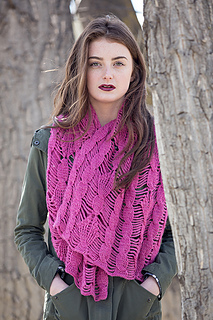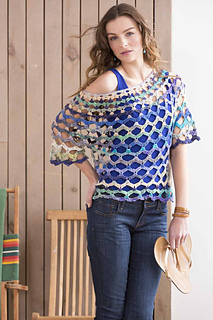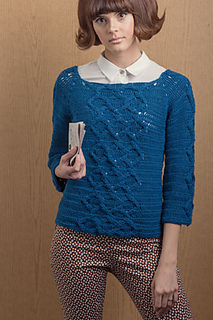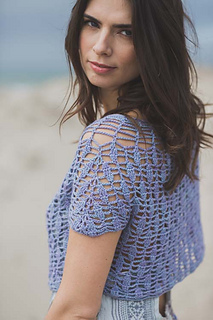


And that experience snowballs: each magazine has its own style of instruction writing, and I’ve become more versatile in my pattern writing. I’ve learned how to write better and more concise patterns, and how to communicate with technical editors when I use innovative or unusual techniques in a pattern.
Great photos of your designs are a common byproduct of magazine work. Some magazines, though not all, take excellent photos of finished designs. Although the designer is not given rights to these photos, which are retained by the magazine or the photographer, we are encouraged to post these photos on social media to help promote the magazine. I can vouch for the fact that a really good photo is a very powerful tool for winning new fans and gaining other designing opportunities.



Finally, magazine work offers the chance to work with a huge array of materials (yarn, fabric, paper crafts) free of charge. I know so much more today about the varieties of yarns, and how the industry cycles through them—one year focusing on color, another on fiber— than I once did. I am more comfortable working with lots of different yarns, and at the same time I understand which weights and fibers work best for the projects I design.
Yet designing for magazines isn’t without its challenges, not the least of which is the time commitment and standard pay. Until about one year ago, standard fees paid by most needle arts magazines were $500 for garments and between $250 and $350 for accessories. We all know this isn’t impressive compensation given the hours it takes to design and make an item, then (in the case of garments) write it up in multiple sizes. Designers must choose to give up on the needle arts business—and many have— or figure out how to make it work for us. We’ve had to do more than design for magazines, whether that is publishing books, teaching, writing, self-publishing patterns, or selling yarn. I have done all but the latter.
Each contract you get from a magazine will be a little different, even though fees are fairly similar. One will ask you to give up all rights forever; another will return the rights to you after a year; some will return the finished design; others never do. I’m often asked if any of these provisions are negotiable. In my experience, other than the fee, editors have very little room to maneuver on contracts. It’s important that they treat all designers the same way, and the policies reflected in their contracts are set by people higher up on the corporate ladder. Even with fees, editors are constrained since they have a fixed budget for each issue of a magazine. The most I’ve asked over a fee that was offered for a design is $50, and usually it’s been granted.
One way to make it work is to hire contract makers so you can produce more designs. At first I was doubtful about whether I could write the whole pattern in my head, and about whether a contract crocheter would do a good job and meet the deadline. But once I saw that I could sell a lot more designs, I pushed myself to get over these concerns. My main strategy was to work with local people who were able to meet with me and show me their work in progress. Mishaps and misunderstandings can always occur, but if you pick your contract makers carefully and maintain good relationships with them, it really can work.
For me, the number of designs I was able to do in a year went from about a dozen to 30 or 40, with a corresponding rise in income. The contract crocheter must be paid out of my fee for the design. Usually it represents approximately one-third to one-half the design fee, and depends on how long the job is likely to take. Clearly, the only way this arrangement enables you to earn more is if you are able to significantly raise the number of designs you are selling.
The last two years or so have been tough for the needle arts industry, which has always been cyclical. Design fees offered now are about $50–100 less per item than they have been in the past. Some magazines have disappeared forever, while others are cutting pages. As a result, many veteran designers are leaving the industry and the editorships of several magazines have changed.
Nevertheless, I would encourage those who are interested in breaking into magazine work to do so now. The advantages I’ve outlined above are still there to be had, and I am seeing many new names in magazines as editors look to new designers to fill their pages.

Dora Ohrenstein
contributor

Dora, your thoughts here are great info. I have to agree with you – one design I submitted for an article in a Bead & Button magazine got me a book deal with a publisher in New York.
Annika,
What your book offer for design work or technical writing? I’d love to hear more details about how you landed that deal. Thanks!
I have a love/hate relationship with magazine work. I’ve written countless articles for various sewing mags since 2009 because that used to be how you broke through in the industry, paying your dues writing articles, bulking up your writing resume, etc. Unbeknownst to me some of those magazines were then selling my patterns in their online stores without my name attached to them and without any royalties. In the online shop of one of the magazines, their best selling digital item (which includes past issues of the mag, as well as all PDF patterns and downloads) is one of my patterns that I was paid $250 for like 6 years ago. It always pops up on their emails and promotions and haunts me to think how much I could have made had I thought about that in my contract. Now that everything is measured in fans and followers I wonder if I should have spent more time creating a blog and a beefier webstore than writing for other people because it’s not their #1 priority to help you get your name out there.
On the other hand I can write and illustrate a tutorial in my sleep now and its lead to some amazing opportunities like a couple of appearances on Sew It All, online sewing classes with Craft Daily, writing for books, and even being a speaker at sewing conferences. (Those things have come from the contacts I made at the magazine and not the writing per se, if you want to get specific.)
In conclusion, I have experience and a writing resume a mile long, I just don’t have much income or even name recognition to show for it. It’s a double edge sword. So my take away? CHECK YOUR CONTRACTS. Don’t give your great ideas away for free. I now get royalties 🙂
Lucy,
I just read this article and your comments today. Sorry for the delayed reply.
I agree with you about not giving away ideas for free, and I also have great hesitation on selling all rights to my work. Sadly, more and more companies want all rights which, for me, limits what I will submit.
For knitting designs, I love Knit Picks’ Independent Designers Program (IDP), which allows designers to keep the rights to their work and publish where they like. This shows tremendous respect for their designers, and I appreciate it. It has kept me a loyal customer, too.
If a designer publishes in one of Knit Picks books, they ask for a two-year exclusive. If memory serves, it used to be a one-year exclusive, which I thought was fantastic, although I can respect their wanting to retain the rights longer. Either way, at least the designer does not lose the right to the work.
I hope Knit Picks keeps these programs as they are. Time will tell.
In the meantime, I would love to hear if anyone has other favorite places to submit and why.
Also, thank you Dora, for this article. I enjoyed it.